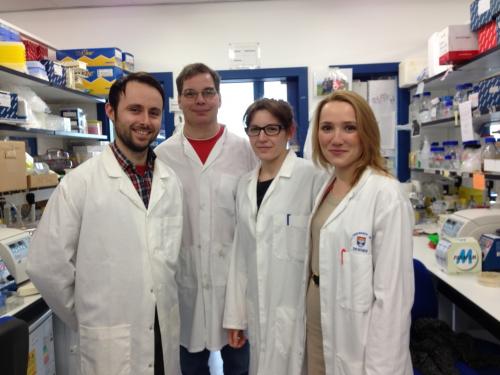
MRC-PPU research uncovers important regulatory mechanism for Cullin-RING E3 ubiquitin ligase complexes
Cullin-RING ligases (CRLs) are multi-subunit ubiquitin E3 enzymes, which ligate the small modifier ubiquitin to other cellular proteins. CRLs are modular complexes containing a core catalytic unit, which is combined with variable substrate-specific adaptors to target a large array of proteins for ubiquitylation. Because of their modularity, CRLs are very versatile and can form hundreds of different E3s, making them the largest family of ubiquitin ligases in the cell.
As all CRLs are built around a common catalytic scaffold, the substrate specificity subunits need to be carefully assembled when they are needed and again disassembled when the substrate has been ubiquitylated. For many years it has been puzzling how this activation and inactivation is achieved at the molecular level.
PhD work performed by Aleksandra ZemÃ…â€_a in the laboratory of Thimo Kurz and published in a recent article in Nature Communications has now shed light on this process. Aleksandra used the well-characterised budding yeast SCF CRL complex to study the dynamics of activation and inactivation of these enzymes. She first identified a trigger that rapidly inactivates SCF by switching yeast cells from growth on fermentable to non-fermentable carbon sources. Aleksandra noticed that during inactivation the substrate-specificity subunits of the SCF are released from the core complex. This observation led her to investigate the requirements for the release, and she discovered that both, a large protein complex called the COP9 Signalosome, and a protein called CAND1 are needed. It has previously been known that the COP9 Signalosome removes a modification from the complex, allowing CAND1 to interact with the CRL. Aleksandra could now show that this sequence of events is required for the removal of substrate specificity modules directly by CAND1. Most importantly, she also demonstrated that the CRL cannot properly be reactivated if the removal is inhibited by mutation of the COP9 Signalosome or CAND1, as 'old' substrate-specificity modules occupy the complex and prevent the binding of new substrate-specific adaptors. As a consequence, SCF substrate ubiquitylation is inhibited.
These findings for the first time shed light on how the dynamic assembly and disassembly of this highly conserved and important class of E3 ubiquitin ligases is regulated. The groups of Dieter Wolf from the Burnham Institute in San Diego and Ray Deshaies from Caltech in Los Angeles published similar findings in the same issue of Nature Communications and of the journal Cell, respectively. All three papers are also covered in a Preview article published in the most recent issue of Cell.
Aleksandra's paper describing her results can be found here, and the Preview in Cell is located here.
As all CRLs are built around a common catalytic scaffold, the substrate specificity subunits need to be carefully assembled when they are needed and again disassembled when the substrate has been ubiquitylated. For many years it has been puzzling how this activation and inactivation is achieved at the molecular level.
PhD work performed by Aleksandra ZemÃ…â€_a in the laboratory of Thimo Kurz and published in a recent article in Nature Communications has now shed light on this process. Aleksandra used the well-characterised budding yeast SCF CRL complex to study the dynamics of activation and inactivation of these enzymes. She first identified a trigger that rapidly inactivates SCF by switching yeast cells from growth on fermentable to non-fermentable carbon sources. Aleksandra noticed that during inactivation the substrate-specificity subunits of the SCF are released from the core complex. This observation led her to investigate the requirements for the release, and she discovered that both, a large protein complex called the COP9 Signalosome, and a protein called CAND1 are needed. It has previously been known that the COP9 Signalosome removes a modification from the complex, allowing CAND1 to interact with the CRL. Aleksandra could now show that this sequence of events is required for the removal of substrate specificity modules directly by CAND1. Most importantly, she also demonstrated that the CRL cannot properly be reactivated if the removal is inhibited by mutation of the COP9 Signalosome or CAND1, as 'old' substrate-specificity modules occupy the complex and prevent the binding of new substrate-specific adaptors. As a consequence, SCF substrate ubiquitylation is inhibited.
These findings for the first time shed light on how the dynamic assembly and disassembly of this highly conserved and important class of E3 ubiquitin ligases is regulated. The groups of Dieter Wolf from the Burnham Institute in San Diego and Ray Deshaies from Caltech in Los Angeles published similar findings in the same issue of Nature Communications and of the journal Cell, respectively. All three papers are also covered in a Preview article published in the most recent issue of Cell.
Aleksandra's paper describing her results can be found here, and the Preview in Cell is located here.

